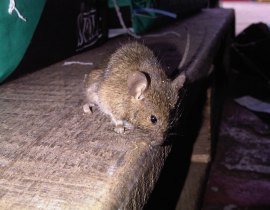Professional Pest Control & Wildlife Management
House Mouse
Originating from Asia the common House Mouse Mus (musculus) domesticus now lives in every corner of the globe, their close association to humans have led them to be one of the most numerous mammals on the planet.
Whilst being seen as cute these rodents share some unpopular characteristics with their larger cousins. Mice get into our homes and are often found in lofts where they can damage property and worse, gnaw through electrical wires. It is common for them to follow water pipes down from a loft through the house arriving under the kitchen sink. Totally incontinent mice poop upto 80 times a day and dribble urine everywhere they run, and they carry diseases too.
If you would like to make an appointment, need advice or would like to ask us a question please use the enquiry form or call us on 01284 799 398.
-
Risks
Like their larger cousins the Rat, Mice carry various diseases including Salmonella, Hantavirus, Lyme disease and other nasty gastro-enteroviruses.
Gnawing through wires in loft cavities can result in electrical fires, 15% of house fires are caused by rodent damage to wiring. Please do ignore those noises in the loft.
The are truly omnivorous and eat anything including wood, carpet, soap, insulation etc.
Their incontinence leads to a lot of waste food products in the kitchen.
-
Treatment
Our rodent treatments begin with an initial survey and treatment, followed by a minimum of two follow-up visits. We provide this service for a set price and if additional visits are required they are made without charge, we also provide minor proofing measures as part of this set fee. We believe our service is second to none and when compared to all our competition, exceptional value.
Our initial survey is to locate and determine which species is causing the infestation, likely entry/access points, harbourages (nests etc) habits and food sources. Whilst carrying this out we conduct a risk assessment to determine any potential hazards to humans, pets, buildings, non-target species (other wildlife) and the environment. Once complete we present the client with our findings with any photographic evidence.
After consulting with you the client we decide upon a course of treatments to solve the problem in the most efficient and humane manner. We often combine more than more technique to achieve results in a minimum amount of time. Treatments at our disposal include rodenticide grains, wax blocks, pasta baits, gels, contact dusts, liquid bait, a variety of humane traps and also live catch traps for re-release. Before we complete our work with you we will endeavour to proof any minor access points, more complex proofing measures will be discussed and priced accordingly.
-
Life Cycle
Weighing between 10 and 25 grams and only eating around 3 grams of food per day you wouldn’t think that they could cause much damage – but they do! Like all rodents they need to gnaw to keep their teeth down, they produce an amazing 80 droppings per day and are incontinent leaving little black grains of rice and urine where ever they travel.
They are superb climbers able to run up brick walls, and they can squeeze through the smallest of gaps, as small as a bic-biro.
A mouse trap from a supermarket might be sufficient to remove a lone mouse in your home, however once a breeding population is established you won’t be able to set the trap quick enough.
Mice breed at an astonishing rate;
- Gestation is 19-21 days,
- After birth the female come back into esterus (season) ready to breed again,
- Litter sizes range from 3 to 14,
- Up to 10 litters per year,
- Young can reach sexual maturity in little as five weeks
- They can breed all year round
- False Widow Spider Removal
- Cluster Fly help
- The trouble with fleas?
- Mole Catching in Suffolk
- Rats in the Garden
- Wasp Nest Control
- Rats in your chicken Coop
- Anaphylaxis
- Bee Swarms
- Honey Bee Relocation
- Rare Breed Poultry
- Pest Control with Birds of Prey
- Un-marked vehicles available
- Rabbiting with Ferrets
- Myxomatosis
- Poll-Tex Mesh
- Honorary Member Russell Wallis
- Free Rabbit Control


